The Intel Core i9-9980XE CPU Review: Refresh Until it Hertz
by Ian Cutress on November 13, 2018 9:00 AM ESTHEDT Performance: Web and Legacy Tests
While more the focus of low-end and small form factor systems, web-based benchmarks are notoriously difficult to standardize. Modern web browsers are frequently updated, with no recourse to disable those updates, and as such there is difficulty in keeping a common platform. The fast paced nature of browser development means that version numbers (and performance) can change from week to week. Despite this, web tests are often a good measure of user experience: a lot of what most office work is today revolves around web applications, particularly email and office apps, but also interfaces and development environments. Our web tests include some of the industry standard tests, as well as a few popular but older tests.
We have also included our legacy benchmarks in this section, representing a stack of older code for popular benchmarks.
All of our benchmark results can also be found in our benchmark engine, Bench.
WebXPRT 3: Modern Real-World Web Tasks, including AI
The company behind the XPRT test suites, Principled Technologies, has recently released the latest web-test, and rather than attach a year to the name have just called it ‘3’. This latest test (as we started the suite) has built upon and developed the ethos of previous tests: user interaction, office compute, graph generation, list sorting, HTML5, image manipulation, and even goes as far as some AI testing.
For our benchmark, we run the standard test which goes through the benchmark list seven times and provides a final result. We run this standard test four times, and take an average.
Users can access the WebXPRT test at http://principledtechnologies.com/benchmarkxprt/webxprt/
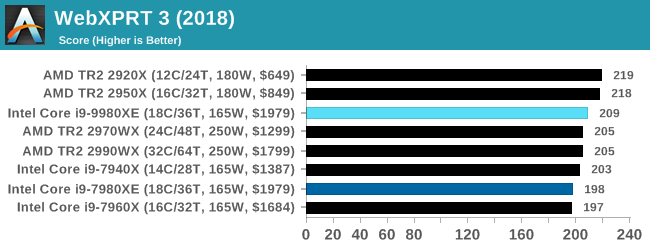
WebXPRT 2015: HTML5 and Javascript Web UX Testing
The older version of WebXPRT is the 2015 edition, which focuses on a slightly different set of web technologies and frameworks that are in use today. This is still a relevant test, especially for users interacting with not-the-latest web applications in the market, of which there are a lot. Web framework development is often very quick but with high turnover, meaning that frameworks are quickly developed, built-upon, used, and then developers move on to the next, and adjusting an application to a new framework is a difficult arduous task, especially with rapid development cycles. This leaves a lot of applications as ‘fixed-in-time’, and relevant to user experience for many years.
Similar to WebXPRT3, the main benchmark is a sectional run repeated seven times, with a final score. We repeat the whole thing four times, and average those final scores.
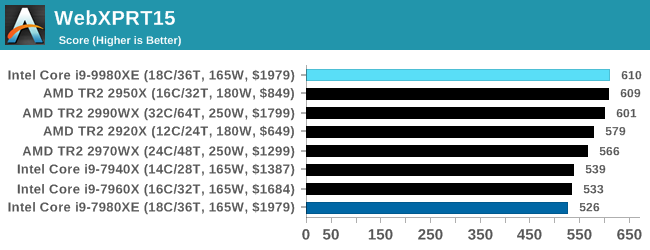
Speedometer 2: JavaScript Frameworks
Our newest web test is Speedometer 2, which is a accrued test over a series of javascript frameworks to do three simple things: built a list, enable each item in the list, and remove the list. All the frameworks implement the same visual cues, but obviously apply them from different coding angles.
Our test goes through the list of frameworks, and produces a final score indicative of ‘rpm’, one of the benchmarks internal metrics. We report this final score.
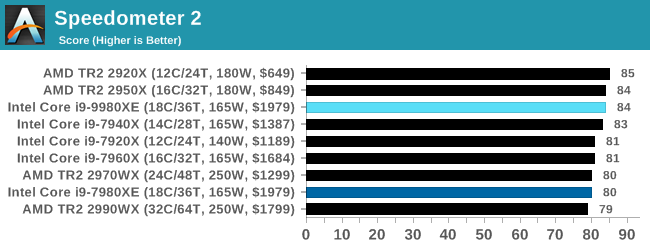
Google Octane 2.0: Core Web Compute
A popular web test for several years, but now no longer being updated, is Octane, developed by Google. Version 2.0 of the test performs the best part of two-dozen compute related tasks, such as regular expressions, cryptography, ray tracing, emulation, and Navier-Stokes physics calculations.
The test gives each sub-test a score and produces a geometric mean of the set as a final result. We run the full benchmark four times, and average the final results.
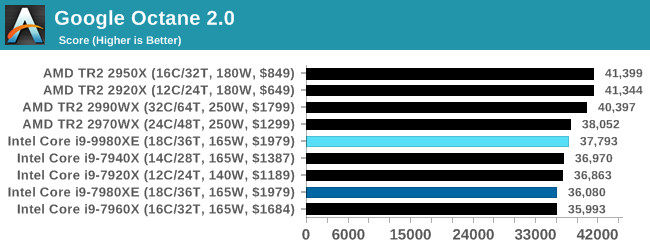
Mozilla Kraken 1.1: Core Web Compute
Even older than Octane is Kraken, this time developed by Mozilla. This is an older test that does similar computational mechanics, such as audio processing or image filtering. Kraken seems to produce a highly variable result depending on the browser version, as it is a test that is keenly optimized for.
The main benchmark runs through each of the sub-tests ten times and produces an average time to completion for each loop, given in milliseconds. We run the full benchmark four times and take an average of the time taken.

3DPM v1: Naïve Code Variant of 3DPM v2.1
The first legacy test in the suite is the first version of our 3DPM benchmark. This is the ultimate naïve version of the code, as if it was written by scientist with no knowledge of how computer hardware, compilers, or optimization works (which in fact, it was at the start). This represents a large body of scientific simulation out in the wild, where getting the answer is more important than it being fast (getting a result in 4 days is acceptable if it’s correct, rather than sending someone away for a year to learn to code and getting the result in 5 minutes).
In this version, the only real optimization was in the compiler flags (-O2, -fp:fast), compiling it in release mode, and enabling OpenMP in the main compute loops. The loops were not configured for function size, and one of the key slowdowns is false sharing in the cache. It also has long dependency chains based on the random number generation, which leads to relatively poor performance on specific compute microarchitectures.
3DPM v1 can be downloaded with our 3DPM v2 code here: 3DPMv2.1.rar (13.0 MB)
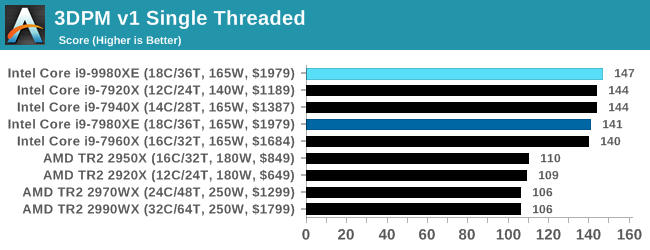
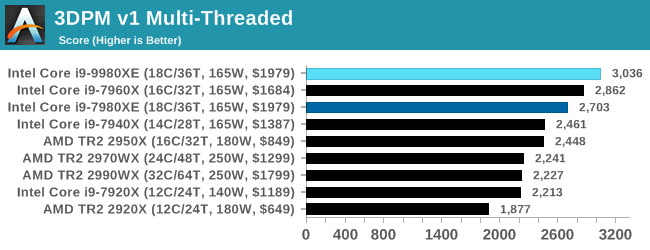
x264 HD 3.0: Older Transcode Test
This transcoding test is super old, and was used by Anand back in the day of Pentium 4 and Athlon II processors. Here a standardized 720p video is transcoded with a two-pass conversion, with the benchmark showing the frames-per-second of each pass. This benchmark is single-threaded, and between some micro-architectures we seem to actually hit an instructions-per-clock wall.
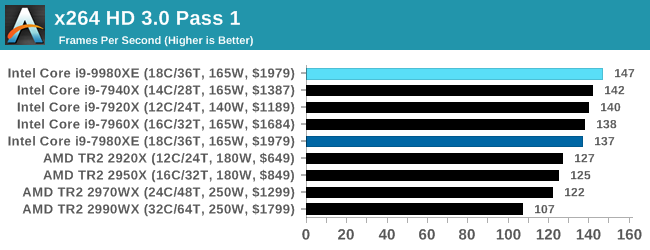
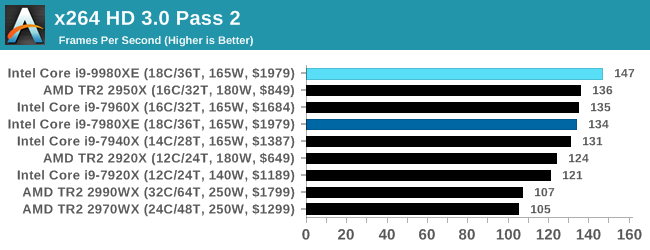










143 Comments
View All Comments
AdhesiveTeflon - Tuesday, November 13, 2018 - link
Yea, have fun waiting a month to render 2 airport terminals from a point cloud. Most professionals I know still use and have a need for desktops. If you're asking why you need this CPU then it's not for you.HStewart - Tuesday, November 13, 2018 - link
Like to see you lug a desktop though an airport.AdhesiveTeflon - Tuesday, November 13, 2018 - link
It's kind of obvious that you leave the desktop stationary for any sort of real work. My comment was how the OP rarely seen any "professionals" use desktops anymore. Engineers, CAD workers, and rendering farms still use desktops because they're still the only thing that has any grunt behind it.So while a laptop is still trying to render the airport's bathroom from the point cloud, the desktop has already done the rest of the airport and the next two point-cloud scanning projects.
HStewart - Tuesday, November 13, 2018 - link
Yes I understand that but most of one you find on forums like this are not actually professionals - but instead hard core gamers - which desktop still have a lot of that market.The ideal platform is mobile platform that connect to desktop style monitors at work and if needed at home. My work required two video ports on Laptop.
Lord of the Bored - Wednesday, November 14, 2018 - link
The ideal platform... depends on the task at hand. Crazy, I know. Some people need a small and light device, some need one they can hook multiple displays too, some need the one with the most raw power available...twtech - Thursday, November 15, 2018 - link
That's fine if you don't need the power of a desktop. Your laptop in that case is essentially serving as a SFF desktop - and if that's good enough, great. You get all the benefits of a desktop, and all the portability advantages of a laptop in a single package.I can see how that works for some forms of software development. For me personally, at work I can use all the CPU power I can get. Around 32 cores @ 5GHz would be perfect.
PeachNCream - Wednesday, November 14, 2018 - link
Render farms do not typically consist of desktop computers. The workloads you're discussing should indeed be processed elsewhere on something other than whatever machine is local to the user's desk and that elsewhere is typically not a collection of desktop-class PC hardware.M O B - Friday, November 16, 2018 - link
PNC--you made a good point earlier about thin clients and servers, but not everyone is corporate. Efficiency is moot if you can't afford to get your foot in the door.I don't expect someone who isn't in the industry to know this, but small businesses and independent contractors do the majority of the transcoding, grading, editing, and effects that make it into every single thing you watch on TV or stream. These people often use powerful 1P desktops, and occasionally a single 2P system. Obviously large effects studios don't rely on 1P, but again, most people in this industry are not employed by one of the few giants.
It's clear that you don't have these needs, but to pretend that this entire marketing segment is for "gaming," "not necessary," or inefficient is gross oversimplification. Thin clients and servers are a great solution for certain operations of scale, while for others it is as tone deaf and ignorant as crying "let them eat cake."
These powerful 1P builds are our daily bread, and if you can get by with a laptop then that's great, but check your ignorance instead of speaking from it.
AdhesiveTeflon - Wednesday, November 14, 2018 - link
HStewart, I agree. My personal work setup is the same way with a laptop and multiple desktop monitors since I don't require the power that the Engineers and CAD workers need. Most of my users that aren't Engineers or CAD designers are the same way too.PeachNCream, we just purchased a dedicated i9 for the workloads for our point-cloud rendering, but each individual engineer/cad worker still requires a beefy computer. Moving one point of our services to a dedicated computer does not stop the daily work on other projects.
MisterAnon - Wednesday, November 14, 2018 - link
You are not a professional then (and if you are a professional they made a bad hire), because unless your job requires to walk around while typing a laptop is absolutely useless for the professional world. A desktop will get work done significantly faster with no drawbacks. You're sitting in a chair all day, not out camping.